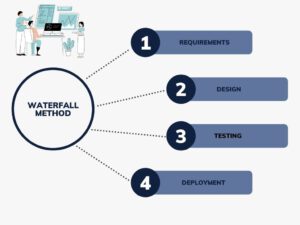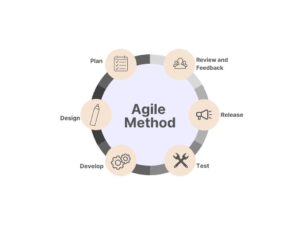
One of the most critical questions companies ask when implementing projects is, “What development method is right for us? ”
Such discussions often can turn into heated debates. In essence, a development strategy is about organizing the work involved in software development. But to avoid confusion, it is essential to note that such methodologies are not about management style or a particular technical procedure. Let’s dive into the two different types of development methods.
1. The Waterfall Methodology:

The Waterfall is a traditional approach. It is a hands-off method where outcomes and goals get set initially. It is less flexible and moving forward requires specific deliverables to be completed.
The Waterfall method is a linear procedure for developing software. It involves a process of events taking place in a specific order. An example sequence includes:
- Designing
- Coding and testing
- Testing the system
- Conducting user acceptance testing
- Fixing all bugs and issues
- Producing the final software
In a Waterfall development project, every step forms a distinct stage of software development. After one step completes, only then the next one can begin. For example, all requirements need to be met and reviewed by clients before the designing stage can start.
Benefits:
- It has a clear structure in comparison with other methodologies. It has a clearly defined set of steps to follow.
- The end goal is specified early. Precise goal setting helps ensure the process is moving in the right direction.
- As the design process is completed early on in the development lifecycle, designing multiple software components in parallel to integrate with external systems.
- Client presence is low except for reviews, approvals, and status meetings.
- It is easier to measure progress as every stage is detailed and known in advance.
- Allows for easy and clean transfer of information as different members are involved in various stages.
Disadvantages:
- The Waterfall is a traditional method that leaves almost no room for sudden revisions or changes.
- It doesn’t involve that client in the process much. But in many industries, clients want to be a part of the entire process.
- The process only tests the software at the end, which is quite risky as more extensive revisions will cause significant delays.
1. Agile

The Agile methodology is a new approach in comparison to the Waterfall approach. It involves a particular kind of rapid application development. The Agile process gets commonly executed using Scrum. Additionally, it consists of many stakeholder interactions and is highly flexible. Hence, the agile method needs team initiative and shorter deadlines.
The emphasis is on quickly delivering an application with complete functional components. All the time gets split into phases called ‘sprints’ instead of creating tasks and schedules.
Each of these ‘sprints’ has a defined time frame of a few weeks. Each phase includes a list of deliverables planned at the beginning of the ‘sprint.’ Every deliverable is assigned a priority based on its business value as determined by the client.
After completing the work, the project team, and the client review and evaluate it; such checks get done in the form of end-of-sprint demonstrations. Agile is known to have a higher client involvement throughout the software project, especially in the reviews.
Benefits:
- The client has earlier chances to view the work in progress. They can make changes and decisions throughout the entire process.
- By using fixed sprints of a few weeks, new features get delivered faster and more frequently. Additionally, Agile offers a high level of predictability.
- The costs are predictable as it is limited to how much the team works in each fixed sprint.
- Allows more room for changes. At the same time, the team needs to deliver the decided product features. But there is an opportunity to review and add changes where required.
- By splitting the project into manageable sprints, the staff can focus more on providing high-quality development, testing, and team collaboration.
Disadvantages:
- Minimal planning at the start means there is no clear vision of how the end product will look. It makes it much easier for the team to get distracted.
- As the Agile process takes place in increments, it’s challenging to track. The delivery happens in stages, which means it’s not possible to set many key performance indicators. Also, tracking would require looking at the entire lifecycle.
- A high degree of client involvement is only a benefit if they show that level of interest and have the time to participate, which is often not the case.
- Agile works well only if every core team member is dedicated to the project.
Both methodologies have their unique take on the software development process. Below, we will compare both to understand the differences between the two procedures.
Comparison Table

Each development method has its own set of pros and cons. It’s essential to understand which one works best for your software project. Below we will discuss which methodology is suitable for different projects.
Which is the Best Methodology for your projects?
There is no perfect method for managing software development. No one method is the best; it depends on your specific project needs. By analyzing the type of project and core components involved, you can choose the most efficient method. Choosing a strategy that caters to most of your project needs is vital.
A few important factors to consider when designing a development methodology are:
- Project focus (whether on activities or the final product)
- Client involvement
- Timeline flexibility
- Budget (fixed or flexible)
- Resistance to change
- Type of Industry
- Number of teams working on the project
- Scalability
- Rigidity of structure
The Waterfall method follows a linear progression; It’s well suited for projects with a clear end goal. For example, suppose the client has a clear-cut vision of the application they want to develop and is confident they do not need any other changes throughout the development.
In that case, the Waterfall approach is a perfect system to follow. Additionally, the budget, timeline, and end goals are all fixed and cannot get altered.
While the Agile method is more about adapting and changing as the project develops, it’s for projects where the outcome depends more on research and testing to complete. Every part of the project is flexible, and there is no definite end goal here.
When looking at the comparison chart and decision factors mentioned above, it becomes easier to decide which process works better for your project.

